Fish Enclosure-Based Vegetable Farming – SESDO Bangladesh
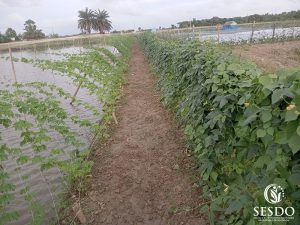
Climate change is one of the most discussed and challenging issues today. Bangladesh is one of the countries affected by climate change. Bangladesh is a densely populated country. Most of the people in the country are engaged in agriculture. But agricultural systems are now under threat due to natural disasters and salinity caused by climate change, and agricultural systems and farmers are currently facing losses.
Satkhira, Khulna, and Bagerhat districts are the very coastal areas of Bangladesh and are directly affected by climate change. The salinity level is constantly increasing in these areas; hence, traditional methods and conventional crops are not being produced properly in these areas. Farmers are facing economic losses every day, and it is becoming difficult for farmers to live. Due to climate change, the poverty rate is increasing, nutritional deficiency is occurring, fresh water is lacking, boys and girls are dropping out of education, child labor is increasing, child marriage is increasing, and children are suffering from various diseases.
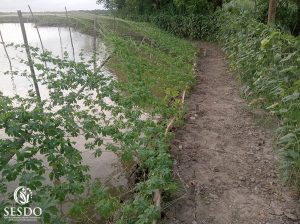
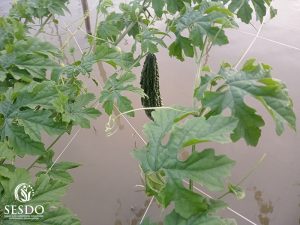
These coastal areas are rich in fish farming due to the brackish waters. The land is raised with earth around it for fish cultivation; it is called a fish enclosure in this area. This elevated part of the ground surrounding a fish enclosure is regionally called the enclosure aisle, or fish cage. Along with fish farming, farmers have started growing vegetables in fish enclosures. Farmers are becoming economically self-sufficient by cultivating vegetables in these enclosures of fish.
Farmers first build huts of bamboo, poles, and nets around the fish enclosures/aisles. Then the soil is prepared for sowing with a little organic manure. The soil is prepared, and then the seeds are sown. Farmers are cultivating various vegetables, including bitter gourd, yardlong bean (barbati), beans, sweet pumpkin, gourd, and papaya, in the fish enclosure. Farmers are getting a good yield of vegetables as the soil in the perimeter aisle is very fertile. Mr. Amal Mallick, a farmer of Shovna village in Shovna union of Dumuria upazila of Khulna district, has cultivated vegetables in the fish enclosure for the last 3/4 years. On the field visit by SESDO (Social and Environmental Sustainable Development Organization), we found that farmer Amal Mallick has cultivated bitter gourds, yardlong beans (barbati), and beans in the aisles, along with fish farming in the fish enclosure. Farmer Amal Mallick said that the bitter gourds and yardlong beans (barbati) have started growing since last week. Last week, he sold 80 kg of bitter gourds and 20 kg of yardlong beans (barbati). He said that good prices for vegetables are now available in the market. Farmer Amal Mallick said that in the next 10 to 15 days, about 500 to 600 kg of bitter gourd will grow every week. Seeing the successful farmer Amal Mallick, many nearby farmers became self-sufficient by growing vegetables in the fish enclosure. And many poor farmers have now shown interest and enthusiasm in growing vegetables in fish enclosures. Another farmer, Mr. Sankar Mallick, said that earlier most of the people of Shovna village were involved only in fish farming, but now many people are becoming economically self-sufficient by farming fish in the fish enclosure as well as vegetables. He said that now most of the vegetables that are available in Khulna city are from this Shovna village. These vegetables from Shobna village are now leaving Khulna city and going to Dhaka. Farmer Amal Mallick said that his total cost this year, including (Gher Hari) is Rs 75,000/=. He expects to make a profit of Rs 1,50,000/2,00000 after excluding all expenses from selling fish and vegetables.
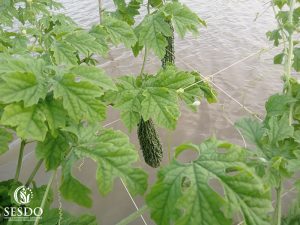
As a result of climate change, various natural disasters, salinity, heavy rains, non-rainfalls, and weather changes, where agricultural systems and farmers are suffering, can be a wonderful example of ensuring food security and improving the quality of life socially. Meanwhile, SESDO (Social and Environmental Sustainable Development Organization) has taken up the CSA-3 formula project. SESDO has been playing a leading role in ensuring sustainable agriculture through Climate Smart Agriculture, Climate Smart Agritourism, and Climate Smart Agroforestry (CSA-3) projects.
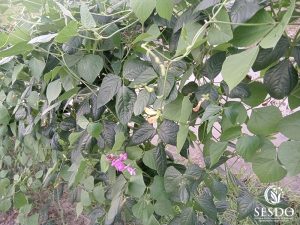
SESDO plans to implement this project, “Fish Enclosure-Based Vegetable Farming” among socially backward communities and small and poor farmers on a larger scale with these successful farmers. Satkhira, Khulna, and Bagerhat are the coastal areas of the Sundarbans. The people of this area are directly affected by climate change. SESDO believes that if this project of “Fish Enclosure-Based Vegetable Farming” can be implemented well, the quality of life of the people in the region will be improved through better training and various forms of support. Sustainable agriculture, social impact, rural development, and implementation of the SDGs to build a world free of hunger are the main goals of SESDO. SESDO’s “Fish Enclosure-Based Vegetable Farming” project is going to be the first project in Bangladesh.
Tapas Kumar Mollick
Executive Director
SESDO (Social and Environmental Sustainable Development Organization)
Satkhira, Bangladesh
